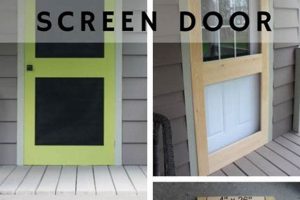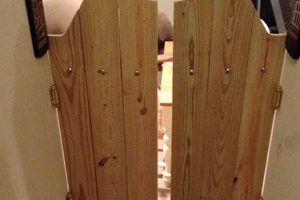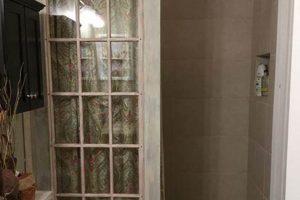A do-it-yourself exterior door designed to protect an entry from inclement weather is a significant home improvement project. This type of door serves as a secondary barrier, offering insulation and shielding against rain, snow, and wind. For example, homeowners often install these protective barriers to enhance energy efficiency and prevent damage to the main entry door.
The advantages of undertaking this kind of project are numerous. A correctly installed protective exterior door can lead to reduced energy consumption by minimizing drafts and heat loss. Furthermore, it extends the lifespan of the primary entry door by safeguarding it from the elements. Historically, these additions were vital in regions with harsh climates, contributing to comfort and energy savings within dwellings.
The subsequent sections will detail the essential steps involved in selecting appropriate materials, measuring the door frame accurately, installing the new unit effectively, and addressing potential challenges that may arise during the process. Detailed information on hardware choices, weatherstripping techniques, and painting or staining options is also presented.
Essential Guidance for a Protective Exterior Door Project
The following recommendations will ensure a successful installation, maximizing the benefits of added protection and energy efficiency.
Tip 1: Accurate Measurements are Critical: Precise measurements of the existing door frame are paramount. Deviation from the correct dimensions can result in improper fit and compromised weather protection. Employ a reliable measuring tool and double-check all dimensions before acquiring materials.
Tip 2: Select Durable Materials: The choice of materials dictates longevity and resistance to environmental factors. Consider aluminum or vinyl for frames, and tempered glass or durable screen mesh for the insert. Prioritize materials designed to withstand the local climate conditions.
Tip 3: Prioritize Proper Sealing: Weatherstripping plays a vital role in preventing drafts and moisture infiltration. Ensure that high-quality weatherstripping is installed around the perimeter of the frame and the door panel. Regularly inspect and replace worn or damaged weatherstripping to maintain optimal sealing.
Tip 4: Ensure Proper Alignment: Correct alignment of the door within the frame is essential for smooth operation and effective sealing. Utilize shims to ensure the frame is plumb and level before securing it to the door jamb. Misalignment can lead to binding and compromised functionality.
Tip 5: Choose Quality Hardware: Select durable and reliable hardware, including hinges, handles, and latches. Opt for corrosion-resistant materials to ensure longevity and smooth operation. Consider adjustable hinges to fine-tune the door’s alignment.
Tip 6: Follow Installation Instructions Carefully: Adherence to the manufacturer’s installation instructions is crucial. Deviations from the recommended procedures can compromise the integrity and functionality of the installed unit. Consult the instructions frequently during the installation process.
Tip 7: Apply Appropriate Finishes: Painting or staining the frame can enhance its aesthetic appeal and provide an additional layer of protection against the elements. Use exterior-grade paints or stains designed for the chosen frame material. Ensure proper surface preparation before applying any finishes.
Implementing these guidelines will enhance the protective exterior doors performance, ensure a weathertight seal, and extend its service life.
The next section will address troubleshooting common issues encountered during installation and ongoing maintenance strategies.
1. Precise Measurements
The connection between precise measurements and a protective exterior door installation is fundamental to its ultimate performance. Inaccurate measurements, even by a small margin, can have significant adverse effects on the project’s success. Precise dimensions are crucial for ensuring a proper fit within the existing door frame, impacting weather sealing, ease of operation, and overall structural integrity. If the storm door is too large, it will not fit. If it is too small, substantial gaps will exist, negating the protective benefits.
The importance of accurate measurements as a component of a do-it-yourself protective exterior door project is evident in several practical scenarios. For instance, a door that is even slightly mismeasured can bind against the frame, making it difficult to open and close. Gaps resulting from imprecise measurements allow air and moisture infiltration, reducing energy efficiency and potentially leading to water damage. Correct measurements, on the other hand, guarantee that the unit sits squarely within the frame, allowing the weatherstripping to create an effective seal. This also ensures the locking mechanism functions correctly.
In summary, obtaining and utilizing precise measurements is non-negotiable when undertaking a storm door installation. Challenges arising from measurement errors necessitate rework, compromise the door’s protective capabilities, and increase costs. Comprehending the significance of accurate dimensions is therefore pivotal to achieving a successful and long-lasting project.
2. Material Durability
Material durability is a paramount consideration in the context of do-it-yourself storm door construction. The protective function and longevity of the structure are directly correlated with the resistance of its constituent materials to environmental stressors, physical impact, and general wear and tear. The selection of appropriate materials is, therefore, not merely an aesthetic decision, but a critical determinant of the installation’s long-term effectiveness.
- Frame Material and Weather Resistance
The frame material of a storm door is the primary structural element and is constantly exposed to the elements. Materials such as aluminum and vinyl are frequently employed due to their inherent resistance to corrosion, rot, and warping. Aluminum offers strength and stability, particularly in high-wind conditions, while vinyl is virtually maintenance-free and can be color-matched to existing siding. Conversely, wood, while aesthetically pleasing, requires regular painting or staining to prevent degradation from moisture and sunlight.
- Glazing and Impact Resistance
The glazing material, typically glass or a polycarbonate derivative, must withstand impacts from debris, hail, and potential forced entry. Tempered glass is a common choice due to its increased strength compared to standard glass, and its tendency to shatter into small, relatively harmless fragments if broken. Polycarbonate materials, such as Lexan, offer even greater impact resistance, making them suitable for areas prone to severe weather events. The choice of glazing material directly influences the door’s ability to provide protection against external threats and maintain its structural integrity over time.
- Screen Mesh Durability
Many storm doors incorporate a screen mesh for ventilation during warmer months. The durability of this mesh is essential for resisting tears, punctures, and sagging. Fiberglass and aluminum mesh are common options, each with its own set of advantages and disadvantages. Aluminum mesh is exceptionally durable and resistant to damage, but may be susceptible to corrosion in coastal environments. Fiberglass mesh is more flexible and less prone to denting, but may degrade more quickly under prolonged exposure to sunlight. The choice of mesh material should be based on local climate conditions and anticipated usage patterns.
- Hardware Corrosion Resistance
Hinges, handles, latches, and other hardware components are susceptible to corrosion, particularly in humid or coastal climates. The use of stainless steel or other corrosion-resistant materials is critical for ensuring the reliable operation and longevity of these components. Inferior hardware can quickly corrode, leading to difficulty opening and closing the door, compromised security, and ultimately, the need for replacement. Investing in high-quality, corrosion-resistant hardware is a prudent investment that will contribute significantly to the storm door’s overall durability.
In conclusion, the selection of durable materials is intrinsic to achieving a successful and long-lasting do-it-yourself storm door installation. Each component, from the frame to the hardware, contributes to the overall resilience of the structure. By carefully considering the properties of different materials and selecting those best suited to the local environment and anticipated usage, individuals can ensure that their projects provide reliable protection and enduring value.
3. Effective Sealing
Effective sealing constitutes a critical element in the functionality and overall performance of any do-it-yourself storm door installation. The primary purpose of a protective exterior barrier is to shield the main entry from the elements, and compromised sealing directly undermines this objective. Comprehensive sealing prevents air infiltration, moisture intrusion, and pest entry, thereby maximizing energy efficiency and minimizing potential damage to the underlying structure.
- Weatherstripping Selection and Installation
Weatherstripping provides a physical barrier against air and water leakage along the perimeter of the door and frame. Various types of weatherstripping exist, including foam, felt, and vinyl, each offering varying degrees of effectiveness and durability. The appropriate selection depends on the gap size and the level of weather resistance required. Proper installation, ensuring a tight and consistent seal, is paramount. Gaps in weatherstripping will negate its intended purpose, allowing drafts and moisture to penetrate the interior.
- Threshold Adjustment and Sealing
The threshold, located at the bottom of the door frame, is a common entry point for drafts and moisture. Adjustable thresholds allow for fine-tuning the seal between the door and the sill. In instances where an adjustable threshold is not present, a sill gasket or sealant can be applied to create a weathertight barrier. Regular inspection and maintenance of the threshold are necessary to ensure continued effectiveness.
- Proper Frame Sealing to Door Jamb
Sealing the storm door frame to the existing door jamb is essential for preventing air and water infiltration around the perimeter of the frame. Caulking or weatherstripping should be applied to create a continuous seal between the frame and the jamb. This step minimizes the potential for drafts and moisture to penetrate the wall cavity, which can lead to structural damage over time.
- Addressing Gaps and Irregularities
Pre-existing irregularities in the door frame or jamb can create gaps that compromise the effectiveness of the sealing. Shims can be used to level and align the storm door frame, ensuring a consistent contact surface for weatherstripping. Filling gaps with expanding foam sealant or caulk can also improve the seal in areas where irregularities are present.
In conclusion, achieving effective sealing in a do-it-yourself storm door project requires a multifaceted approach, encompassing careful selection of materials, meticulous installation techniques, and ongoing maintenance. Failure to address any one of these facets can significantly reduce the performance of the door, negating its intended benefits. A comprehensively sealed storm door not only enhances energy efficiency and protects the underlying structure but also contributes to a more comfortable and secure living environment.
4. Proper Alignment
Proper alignment is a critical determinant of a protective exterior door’s functionality and longevity. In the context of a do-it-yourself installation, meticulous attention to alignment is essential for ensuring smooth operation, effective weather sealing, and overall structural integrity. Misalignment can lead to a cascade of problems, negating the intended benefits of the installation.
- Frame Squareness and Plumbness
The door frame must be perfectly square and plumb within the existing door jamb. Any deviation from squareness will cause the door to bind or rub against the frame, making it difficult to open and close. Plumbness ensures that the door hangs vertically and closes evenly along its entire length. Shims are commonly used to adjust the frame and achieve perfect squareness and plumbness. Failure to properly square and plumb the frame will result in operational issues and compromised weather sealing.
- Door Panel and Frame Alignment
The door panel itself must be correctly aligned within the frame. If the panel is not flush with the frame, gaps will exist, allowing air and moisture infiltration. Adjustable hinges can be used to fine-tune the panel’s position and ensure a consistent seal. In some cases, planing the door panel may be necessary to correct minor alignment issues. Proper alignment of the door panel and frame is essential for effective weather protection and smooth operation.
- Latch and Strike Plate Alignment
The latch mechanism must align precisely with the strike plate to ensure secure closure. If the latch and strike plate are misaligned, the door may not latch properly, compromising security and allowing drafts. Adjusting the position of the strike plate or the latch mechanism may be necessary to achieve proper alignment. A misaligned latch can also cause the door to rattle in windy conditions, creating noise and discomfort.
- Hinge Alignment and Functionality
Hinges must be properly aligned to allow the door to swing freely and smoothly. Misaligned hinges can cause the door to bind, squeak, or even fail prematurely. Using shims behind the hinges can correct minor alignment issues. In severe cases, it may be necessary to replace the hinges entirely. Proper hinge alignment is critical for ensuring the long-term functionality and durability of the protective barrier.
In summary, proper alignment is a multifaceted aspect of a do-it-yourself exterior door project, encompassing frame squareness, panel alignment, latch alignment, and hinge functionality. Meticulous attention to each of these details is essential for achieving a successful installation that provides reliable protection, smooth operation, and long-lasting performance.
5. Hardware Quality
Hardware quality directly influences the performance and longevity of a do-it-yourself protective exterior door installation. The reliability of hinges, handles, latches, and other components determines ease of use, security, and resistance to wear and environmental factors. Substandard hardware can compromise the overall functionality and protective capabilities of the structure, leading to premature failure and increased maintenance requirements.
- Hinge Durability and Load Capacity
Hinges bear the weight of the door and facilitate its smooth operation. Low-quality hinges may exhibit premature wear, corrosion, or even failure under load, leading to sagging or binding. Durable hinges, constructed from materials such as stainless steel or heavy-gauge steel, ensure long-term functionality and reliable support. Selecting hinges with an appropriate load capacity based on the door’s weight is essential for preventing premature wear and maintaining proper alignment.
- Latch Security and Weather Resistance
The latch mechanism provides security against forced entry and maintains a weathertight seal. Inferior latches may be susceptible to corrosion, jamming, or forced entry. High-quality latches, constructed from corrosion-resistant materials and incorporating robust locking mechanisms, enhance security and withstand exposure to the elements. Selecting a latch that conforms to established security standards provides an additional layer of protection.
- Handle Ergonomics and Material Strength
Handles provide a point of contact for opening and closing the door. Ergonomic designs enhance user comfort, while durable materials ensure resistance to breakage and wear. Handles constructed from materials such as aluminum, stainless steel, or high-impact polymers offer a balance of aesthetics, durability, and corrosion resistance. Selecting a handle that is both comfortable to use and resistant to damage contributes to the overall user experience and extends the lifespan of the installation.
- Fastener Corrosion Resistance and Strength
Fasteners, such as screws and bolts, secure the hardware components to the door frame and panel. Low-quality fasteners may be susceptible to corrosion or breakage, compromising the integrity of the installation. Corrosion-resistant fasteners, constructed from materials such as stainless steel or coated steel, prevent rust and ensure a secure connection over time. Selecting fasteners with an appropriate strength rating based on the load requirements is essential for preventing premature failure and maintaining structural stability.
In conclusion, hardware quality is an indispensable aspect of a do-it-yourself storm door project. The selection of durable, corrosion-resistant, and properly sized hardware components directly impacts the functionality, security, and longevity of the installation. Investing in high-quality hardware is a prudent decision that minimizes maintenance requirements, enhances security, and ensures that the protective exterior door performs its intended function effectively for years to come.
6. Secure Installation
A secure installation of a do-it-yourself storm door directly influences its capacity to fulfill its intended purpose: protection against the elements and enhancement of home security. A poorly installed storm door, irrespective of material quality, is vulnerable to damage from wind, rain, and forced entry. The connection between secure installation and the door’s functionality is causal; improper techniques directly undermine the storm door’s protective capabilities. For instance, a frame inadequately anchored to the door jamb is prone to displacement during high winds, negating any insulation or security benefits. A secure installation is not merely a final step but an integral component interwoven with material selection and alignment considerations.
The practical application of a secure installation methodology involves several crucial steps. Proper anchoring necessitates the use of appropriately sized and rated fasteners suited for the wall’s composition, be it wood, brick, or concrete. Incorrect fastener selection can lead to inadequate holding power, predisposing the unit to dislodgement. Furthermore, shimming the frame during installation ensures even distribution of weight and prevents warping, a common cause of operational difficulties. Sealing the perimeter with a high-quality caulk is also crucial to prevent water infiltration, which can compromise the structural integrity of both the storm door and the surrounding wall. These steps, when executed precisely, contribute to a stable and weathertight installation.
In summation, secure installation is paramount to realizing the full benefits of a do-it-yourself storm door. Challenges often arise from inadequate preparation, incorrect tool usage, or a lack of understanding of structural principles. Overcoming these obstacles requires diligent adherence to manufacturer instructions, consultation with experienced professionals when necessary, and a commitment to meticulous execution. A secure installation not only extends the lifespan of the storm door but also provides tangible benefits in terms of energy savings, enhanced security, and improved home comfort.
Frequently Asked Questions
The following addresses common inquiries concerning the installation and maintenance of a do-it-yourself storm door. These responses aim to clarify key aspects related to the successful completion of such projects.
Question 1: What tools are essential for installing a storm door?
Essential tools typically include a measuring tape, level, drill with various bits, screwdriver (both Phillips and flathead), a hammer, safety glasses, and a caulk gun. Depending on the doorframe material, a saw may also be necessary for trimming. It is prudent to consult the specific installation instructions for the chosen door model to ensure all required tools are available.
Question 2: How can accurate measurements of the doorframe be ensured?
Accurate measurements necessitate using a reliable measuring tape and taking multiple measurements at different points (top, middle, and bottom) within the doorframe opening. The smallest measurement should be used to ensure the new door will fit without requiring extensive modifications. Measurements should be recorded in both inches and millimeters for precision.
Question 3: What type of weatherstripping is most effective for sealing a storm door?
The efficacy of weatherstripping depends on the gap size and environmental conditions. Vinyl weatherstripping is generally durable and suitable for various gap sizes. Foam weatherstripping offers a cost-effective solution for smaller gaps. Magnetic weatherstripping provides a tight seal but may require precise alignment. Selecting weatherstripping rated for exterior use is crucial for longevity.
Question 4: How is proper alignment of the storm door within the frame achieved?
Proper alignment requires using shims to level and plumb the doorframe within the opening. A level should be used to ensure the frame is vertically and horizontally aligned. Shims should be strategically placed behind the frame to correct any discrepancies. Overtightening fasteners before proper alignment can result in a skewed installation.
Question 5: What type of maintenance is required for a storm door?
Routine maintenance involves cleaning the door surface with a mild detergent, inspecting weatherstripping for damage, lubricating hinges and latches, and tightening any loose screws. Annually, the door should be inspected for signs of corrosion or wear, and any necessary repairs or replacements should be performed promptly.
Question 6: How can condensation buildup on a storm door be prevented?
Condensation buildup indicates a difference in temperature and humidity between the interior and exterior. Ensuring adequate ventilation can mitigate this issue. This can be achieved by opening the storm door slightly on milder days or installing a storm door with built-in ventilation features. Addressing underlying insulation issues in the home may also reduce condensation.
The information provided serves as a general guide. Specific procedures may vary depending on the type and model of the particular storm door being installed. Always refer to the manufacturers instructions for detailed guidance.
The next article section will provide a checklist to help guide the DIY Storm Door installation.
Conclusion
The preceding discussion explored the critical elements involved in a diy storm door project. Attention was given to accurate measurements, durable material selection, effective sealing techniques, proper alignment procedures, hardware quality considerations, and secure installation practices. Each factor directly influences the overall performance, longevity, and security provided by such an undertaking. Mastery of these considerations ensures the successful implementation of a protective exterior door.
The information presented enables individuals to make informed decisions regarding weather barrier installation. Proper execution of these principles results in energy savings, enhanced home security, and long-term protection from the elements. Continued research and adherence to evolving best practices will further optimize the benefits derived from this essential home improvement endeavor.







